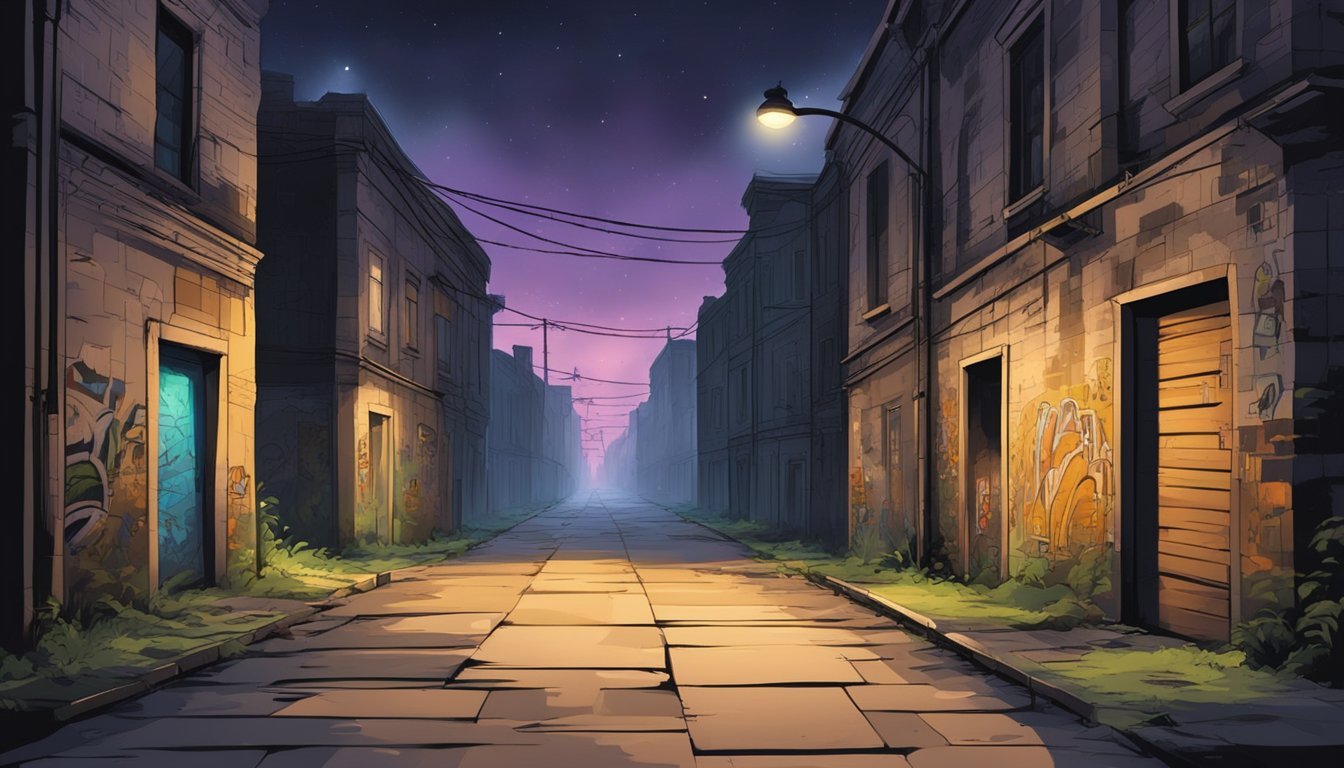Brooklyn Strangler: Vincent Johnson's Urban Hunting Ground
A Timeline of Terror in New York City
Vincent Johnson, known as the Brooklyn Strangler, terrorized New York City's Brooklyn borough in the late 1990s and early 2000s. His crimes sent shockwaves through the community, particularly in the neighborhoods of Williamsburg and Bedford-Stuyvesant. Johnson targeted and murdered sex workers, exploiting the urban landscape of Brooklyn as his hunting ground.
The case of the Brooklyn Strangler gripped the city and became a subject of intense media scrutiny. Johnson's reign of terror lasted for several months, during which he strangled multiple victims. His actions not only devastated families but also highlighted the vulnerabilities of marginalized communities in urban areas.
The pursuit and eventual capture of Vincent Johnson marked a significant chapter in Brooklyn's history. The investigation into his crimes involved extensive police work and forensic analysis. The Brooklyn Strangler case has since been featured in various true crime documentaries, shedding light on the dark underbelly of city life and the complexities of tracking down a serial killer in a densely populated urban environment.
Profile of Vincent Johnson
Vincent Johnson, known as the Brooklyn Strangler, was an American serial killer who terrorized New York City in the late 1990s and early 2000s. His criminal activities and background provide insight into the man behind the murders.
Early Life and Background
Vincent Johnson was born on January 6, 1969. He grew up in the foster care system, which likely contributed to his troubled upbringing. Johnson's early life was marked by instability and a lack of consistent parental figures.
As a young adult, Johnson struggled with relationships. In 1990, at age 21, he had violent altercations with his live-in girlfriend, Patricia Carter. This pattern of aggression foreshadowed his future criminal behavior.
Johnson eventually became homeless in Brooklyn, living on the streets of Williamsburg and Bedford-Stuyvesant. These neighborhoods would later become his hunting grounds.
Psychological Profile
Johnson's psychological makeup was complex. His experiences in the foster system and subsequent homelessness likely contributed to feelings of isolation and resentment.
Experts believe Johnson may have harbored deep-seated anger towards women, particularly those involved in sex work. This anger manifested in his choice of victims and method of killing.
Johnson's ability to evade capture for an extended period suggests a level of cunning and adaptability. He likely possessed a superficial charm that allowed him to approach his victims without arousing immediate suspicion.
Alias: The Brooklyn Strangler
The moniker "Brooklyn Strangler" was given to Johnson due to his modus operandi and the location of his crimes. Between 1999 and 2000, he targeted prostitutes in Williamsburg and Bedford-Stuyvesant.
Johnson's method of killing involved strangulation, earning him his infamous nickname. His victims were found in various locations throughout Brooklyn, creating fear and unrest in the community.
Law enforcement initially struggled to identify the killer, considering up to 30 suspects before narrowing in on Johnson. His arrest brought relief to a city gripped by the fear of an active serial killer.
Crimes Committed
Vincent Johnson, known as the Brooklyn Strangler, committed a series of murders targeting sex workers in Brooklyn between 1999 and 2000. His crimes shocked the community and left a lasting impact on New York City.
Known Victims
Johnson's known victims were all women involved in sex work. They included:
Patricia Sullivan, 50 years old
Rhonda Tucker, 21 years old
Joanne Feliciano, 35 years old
Vivian Caraballo, 26 years old
Laura Nusser, 43 years old
Katrina Niles, another sex worker, survived an attack by Johnson. Her testimony later proved crucial in identifying him as the Brooklyn Strangler.
Methodology
Johnson's modus operandi was consistent across his crimes. He would:
Target prostitutes in Brooklyn neighborhoods
Lure victims to secluded areas
Engage in sadomasochistic sex acts
Strangle the women, typically using their own clothing
Johnson left minimal physical evidence at crime scenes. However, investigators found traces of his saliva on some victims' bodies. This DNA evidence eventually led to his arrest and conviction.
Johnson's attacks occurred between August 26, 1999, and June 7, 2000. The frequency of his murders increased over time, indicating an escalation in his violent behavior.
Investigation Timeline
The hunt for the Brooklyn Strangler unfolded over several years, involving intense detective work and forensic analysis. Key breakthroughs eventually led investigators to Vincent Johnson.
Initial Clues and Breakthroughs
In the late 1990s, a series of murders in Brooklyn caught the attention of law enforcement. The victims were primarily sex workers, found strangled in abandoned buildings. Detectives from Brooklyn North homicide unit took charge of the investigation.
Initial evidence was scarce, but investigators noted similarities in the victims' profiles and cause of death. DNA samples were collected from crime scenes, though no matches were found in existing databases.
The case gained momentum when authorities linked the murders through forensic evidence. This breakthrough allowed police to focus their efforts on a single perpetrator, now dubbed the Brooklyn Strangler.
Capture and Arrest
The investigation intensified in 2000 as more victims were discovered. Detectives conducted extensive interviews and surveillance in areas frequented by the victims. A crucial lead emerged when a potential victim escaped an attack and provided a description of her assailant.
In August 2000, police arrested Vincent Johnson, a 31-year-old Brooklyn resident. DNA evidence collected during his arrest matched samples from multiple crime scenes. Johnson was charged with six murders, though investigators suspected he may have been responsible for additional deaths.
The arrest of the Brooklyn Strangler brought relief to a community terrorized by his actions. Johnson's capture marked the culmination of years of dedicated police work and forensic analysis.
Trial and Sentencing
Vincent Johnson faced justice for his heinous crimes in 2001. Prosecutors presented a strong case against him, including DNA evidence linking him to multiple victims.
Johnson initially pleaded not guilty to the charges. However, as the trial progressed, he changed his plea to guilty on three counts of second-degree murder.
The court sentenced Johnson to three consecutive terms of 25 years to life in prison. This ensured he would remain behind bars for a minimum of 75 years before any possibility of parole.
Johnson's sentencing brought a sense of closure to the victims' families and the Brooklyn community. It marked the end of a terrifying chapter in the borough's history.
Since his conviction, Johnson has been serving his sentence at Wende Correctional Facility in Alden, New York. His earliest possible release date is decades away, effectively ensuring he will spend the rest of his life in prison.
Impact on the Communities
Vincent Johnson's crimes profoundly affected Brooklyn neighborhoods, particularly Bedford-Stuyvesant and Williamsburg. His actions created an atmosphere of fear and heightened vigilance among residents, especially women.
Bedford-Stuyvesant
Bedford-Stuyvesant, a predominantly African American neighborhood, experienced significant distress during Johnson's reign of terror. Local businesses saw a decline in foot traffic as residents, particularly women, avoided going out alone.
Community organizations mobilized to increase safety measures. They organized neighborhood watch groups and self-defense classes for women. Street lighting was improved in dimly lit areas to enhance visibility and deter potential criminals.
The police presence in Bedford-Stuyvesant intensified. Officers patrolled the streets more frequently, and community policing efforts were strengthened to build trust with residents.
Williamsburg
Williamsburg, a diverse neighborhood undergoing gentrification, faced unique challenges in the wake of Johnson's crimes. The area's transformation from an industrial zone to a trendy hotspot was temporarily slowed.
Real estate values in Williamsburg experienced a short-term dip as potential buyers hesitated due to safety concerns. Local bars and restaurants reported decreased evening patronage, impacting the neighborhood's burgeoning nightlife scene.
Community leaders worked to restore Williamsburg's image. They organized street fairs and cultural events to bring people together and reclaim public spaces. The local arts community used their platforms to raise awareness about women's safety and support victims' families.
Media and Cultural Depiction
Vincent Johnson's crimes as the Brooklyn Strangler captivated public attention and media outlets. His case became a subject of intense scrutiny and fascination in true crime circles.
News Coverage
The Brooklyn Strangler case dominated local New York City headlines in the late 1990s and early 2000s. Major newspapers like The New York Times and New York Post provided extensive coverage of Johnson's crimes, arrest, and trial. Television news stations aired frequent updates as the investigation unfolded.
Law enforcement officials held press conferences to share developments and appeal for public assistance. The media closely followed the hunt for the elusive killer, reporting on potential suspects and evidence.
After Johnson's arrest in August 2000, news outlets delved into his background and motives. Interviews with victims' families and community members highlighted the impact of his crimes on Brooklyn neighborhoods.
True Crime Adaptations
The Brooklyn Strangler case has been featured in numerous true crime documentaries and television shows. Investigation Discovery aired an episode about Johnson in their "Evil Lives Here" series. The case was also covered on A&E's "American Justice" program.
Several podcasts have explored the Brooklyn Strangler murders. "Crime Junkie" and "Morbid: A True Crime Podcast" released episodes detailing Johnson's crimes and capture. These adaptations often include interviews with investigators and crime experts.
True crime books have also examined the case. "Midnight in Brooklyn: The Hunt for the Brooklyn Strangler" by Michael Benson provides an in-depth look at the investigation and Johnson's background.






